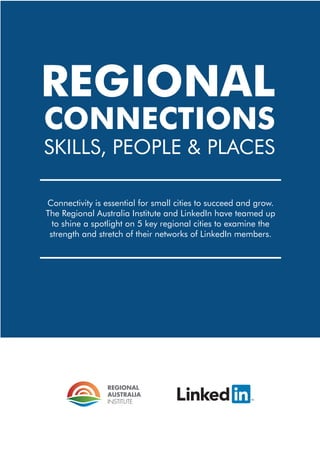Linkedin_handout_web
- 1. COVER PAGE Intro paragraph Connectivity is essential for small cities to succeed and grow. The Regional Australia Institute and LinkedIn have teamed up to shine a spotlight on 5 key regional cities to examine the strength and stretch of their networks of LinkedIn members. REGIONAL CONNECTIONS SKILLS, PEOPLE & PLACES
- 2. TOWNSVILLE SUNSHINE COAST â NOOSA GREATER NEWCASTLE WOLLONGONG LAUNCESTON CONNECTIVITY is essential for small cities to succeed and grow. 295K+ members in these cities, ~30% of the working population WORKING AGE POPULATION: 132,393 (39,000 LinkedIn members) KEY FACTS Post-mining boom transition to a more diverse economy Largest employers: Health, public admin and safety, and retail WORKING AGE POPULATION: 211,067 (82,000 LinkedIn members) KEY FACTS Lifestyle destination Rebuilding itself as a Smart City Largest employers: Health, retail and construction WORKING AGE POPULATION: 364,087 (105,000 LinkedIn members) KEY FACTS 5 Local Government Areas (LGAs) Previously industrial Shifting to a service economy Largest employers: Health, retail and manufacturing WORKING AGE POPULATION: 180,451 (53,000 LinkedIn members) KEY FACTS Historically known for steel and coal Shifting to a service economy Largest employers: Manufacturing, retail and health WORKING AGE POPULATION: 57,886 (16,000 LinkedIn members) KEY FACTS Transitioning from manufacturing to a more diverse economy Largest employers: Health, education and training, and retail 92 avg. connections per member in Australia % = percentage of connections to the specified area % = percentage of people connected to others inside and outside of the specified area 29% connections in the region 20% international connections CONNECTIONS CONNECTIONS 17% connections in the region 25% international connections connections in the region CONNECTIONS 31% 18% international connections CONNECTIONS 21% connections in the region 22% international connections CONNECTIONS 75 90 87 86 67 24% connections in the region 20% international connections TOP 5 CONNECTION LOCATIONS 1. Townsville Area (28.9%) 2. Brisbane Area (16.3%) 3. Sydney Area (6.9%) 4. Melbourne Area (5.5%) 5. Queensland (4.7%) TOP INTERNATIONAL 13. Papua New Guinea (0.9%) TOP 5 CONNECTION LOCATIONS 1. Brisbane Area (25.3%) 2. Queensland (17.5%) 3. Sydney (10.8%) 4. Melbourne Area (7.8%) 5. Perth Area (2.7%) TOP INTERNATIONAL 9. London, United Kingdom (1.2%) TOP 5 CONNECTION LOCATIONS 1. Newcastle Area (31.0%) 2. Sydney Area (25.2%) 3. Melbourne Area (6.3%) 4. Brisbane Area (6.1%) 5. New South Wales (2.9%) TOP INTERNATIONAL 11. London, United Kingdom (0.9%) TOP 5 CONNECTION LOCATIONS 1. Sydney Area (51.1%) 2. Melbourne Area (6.8%) 3. Brisbane Area (4.5%) 4. Wollongong Area (3.7%) 5. Perth Area (1.9%) TOP INTERNATIONAL 10. London, United Kingdom (1.1%) TOP 5 CONNECTION LOCATIONS 1. Launceston (24.3%) 2. Tasmania - other (15.8%) 3. Melbourne Area (12.2%) 4. Sydney Area (7.8%) 5. Brisbane Area (4.9%) TOP INTERNATIONAL 10. London, United Kingdom (0.9%) TOP 5 CONNECTED INDUSTRIES Mining & Metals Construction Financial Services IT Real Estate IT TOP 5 CONNECTED INDUSTRIES Mining & Metals Construction Financial Services Real Estate Financial Services TOP 5 CONNECTED INDUSTRIES Construction ITReal Estate Health & Wellness TOP 5 CONNECTED INDUSTRIES ConstructionFinancial Services Marketing & Advertising Mining & Metals IT Marketing & Advertising TOP 5 CONNECTED INDUSTRIES ConstructionFinancial Services IT Real Estate PER MEMBER PER MEMBER PER MEMBER PER MEMBER PER MEMBER
- 3. TOWNSVILLE SUNSHINE COAST â NOOSA GREATER NEWCASTLE WOLLONGONG LAUNCESTON TOP 5 SKILLS 1. IT Infrastructure and System Management (5.3%) 2. Healthcare Management (4.4%) 3. Process and Project Management (2.4%) 4. Education and Teaching (2.3%) 5. Ecology and Environmental Science (2.0%) TOP 5 SKILLS 1. Healthcare Management (4.1%) 2. IT Infrastructure and System Management (3.5%) 3. Education and Teaching (2.3%) 4. Graphical Design (2.3%) 5. Management and Leadership (2.1%) CURRENT SKILL SHORTAGES TOP 5 SKILLS 1. IT Infrastructure & System Management (5.7%) 2. Healthcare Management (3.8%) 3. Process and Project Management (2.6%) 4. Education and Teaching (2.0%) 5. Lean Manufacturing and Quality Management (1.9%) TOP 5 SKILLS 1. IT Infrastructure and System Management (6.0%) 2. Healthcare Management (3.6%) 3. Education and Teaching (3.1%) 4. Process and Project Management (2.5%) 5. Management and Leadership (2.3%) TOP 5 SKILLS 1. Healthcare Management (3.8%) 2. IT Infrastructure and System Management (3.5%) 3. Education and Teaching (2.9%) 4. Graphical Design (2.0%) 5. Marketing Event Management (1.4%) SKILLS WITH THE HIGHEST MOBILITY SKILLS WITH THE HIGHEST MOBILITY SKILLS WITH THE HIGHEST MOBILITY SKILLS WITH THE HIGHEST MOBILITY SKILLS WITH THE HIGHEST MOBILITY Recruiting (21.8%) Recruiting (20.0%) Business Development & Relationship Management (19.1%) Management & Leadership (16.9%) Social Media Marketing (25.3%) Software Engineering Management & Requirements Gathering (23.3%) Administrative & Office Management (21.0%) Social Media Marketing (29.8%) Social Media Marketing (35.6%) Digital & Online Design & Publishing (24.0%) Digital & Online Marketing (24.0%) Retail Store Operations (20.5%) Business Development & Relationship Management (20.0%) Event Planning & Management (15%) Financial Analysis & Modeling (16.8%) 1. .NET & other Microsoft Application Development 2. Database Management & Software 3. User Interface CURRENT SKILL SHORTAGES 1. Tax 2. Financial Planning 3. .NET & other Microsoft Application Development CURRENT SKILL SHORTAGES 1. Perl / Python / Ruby 2. Java Development 3. .NET & other Microsoft Application Development % = percentage of members with specified skill % = percentage of working population with specified skill, who have changed jobs in the last 12 months SKILLS There is a skill shortage when current demand based on recruiter outreach is greater than the supply, based on the number of people with this skill



